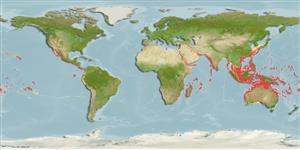Common names from other countries
Classification / Names / Names
ماع يماسا | فدارتم | Catalog of Fishes (gen., sp.) | ITIS | CoL | WoRMS
Environment: milieu / climate zone / depth range / distribution range
يسانش موب
; قمع تارييغت 5 - 112 m (Ref. 3174). Tropical
Indo-Pacific: From the Red Sea and East Africa to Hawaii and French Polynesia.
Length at first maturity / Size / Weight / نس
Maturity: Lm ? range ? - ? cm Max length : 20.0 cm CW يسنج صاوخ نودب / رن سنج; (Ref. 3174); 17.2 cm CW (female)
Carapace rounded, as wide as or slightly wider than long; surfaces convex, with dense pubiscence; 5 anterolateral teeth, median ones largest. No spine present on outer margin of dactylus of last walking leg. Color: light brown overall with pink fingers.
Largest dromiid known (Refs. 343, 122680). Epizoic. Subtidal on hard bottom (Ref. 106854). Occurs at depths of 5 to 50 m. Prefers moderately shallow waters with rocky-muddy substrates, sometimes near reefs. Omnivorous, feeds on sea stars. Carries sponges and colonial tunicates on its back for camouflage (Ref. 343). Can occasionally be found sheltering under old bivalve shells (Ref. 125338). Predator (Ref. 128960).
Life cycle and mating behavior
غولب | لثم دیلوت | یزیر مخت | اه مخت | Fecundity | )ورال ( دازوت
Members of the order Decapoda are mostly gonochoric. Mating behavior: Precopulatory courtship ritual is common (through olfactory and tactile cues); usually indirect sperm transfer.
یلصا ذخآم
عجارم | هدننك گنهامه | ناراكمه
Ng, P.K.L. 1998. (Ref. 343)
NCUI زمرق تسرهف رد تيعضو (Ref. 130435)
ستياس رظن زا تيعضو (Ref. 108899)
Not Evaluated
Not Evaluated
یناسنا هدافتسا
تاليش – يريگ يهام: كدنا يراحت شزرا
| FishSource |
اهرازبا
يتنرتنيا عبانم
Estimates based on models
Preferred temperature
(Ref.
115969): 22 - 29, mean 27.8 (based on 1662 cells).
یريذپ بيسآ
Low vulnerability (10 of 100).
تميق هقبط
Unknown.
